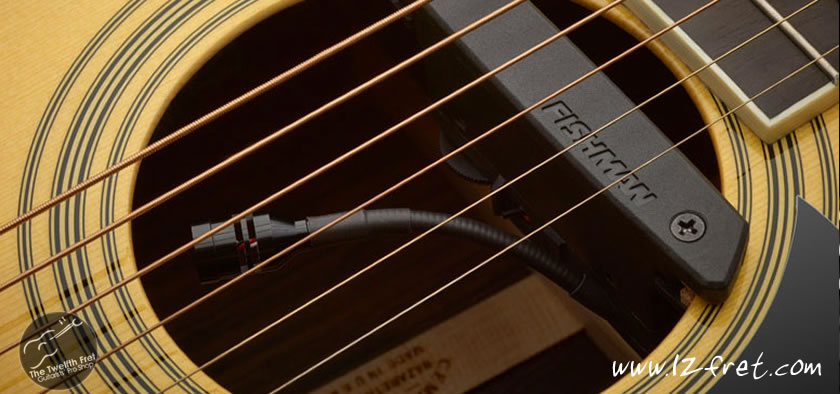
Acoustic Guitar Pickups And Which One Is Right
Amplifying acoustic guitars is always a bit of a challenge. Capturing the lush, natural tone of your favourite guitar is not easy to do without introducing feedback, unwanted handling noise, and a list of other annoyances. But with so many pickups on the market, how do you choose the best one for your guitar? Which acoustic pickup is right for you? Today we’re going to do a little rundown through some of our favourites here at the Twelfth Fret, and what the differences are between them.
Before we look at the pickups themselves, a note about expectations. No acoustic guitar pickup on the market will sound as good as a half-decent microphone on a stand in front of your guitar. Pickups simply don’t have the ability to capture the projection and tonal characteristics the way a microphone does. If you are playing in a live situation where standing in front of a microphone is a feasible way to amplify your guitar, then that is your best bet. However, microphones are potentially problematic. They can feedback easily, and they are ultra-sensitive to placement and distance (meaning you can’t move at all while you play without affecting your amplified sound). There are plenty of situations where using a microphone to amplify your guitar on stage is simply not going to work. In those situations, it is time to look at installing a pickup in your guitar. And even then, you may want to consider combining your pickup with a microphone on a stand in front of you. With your guitar’s internal pickup doing all the “heavy lifting”, you can add a microphone into the mix just to help capture a little of your guitar’s projection. Since the Mic isn’t the only source of amplification for your guitar anymore, it won’t need to be as hot, so feedback can be more easily avoided. And if you move around on stage a little, your guitar won’t disappear from the mix.
With that out of the way, let’s look at few of the basic categories of acoustic guitar pickups, as well as some of the more popular brands and models in each category.
Transducer Pickups
A transducer pickup is essentially a form of sensor that attaches directly to your guitar and “feels” vibration. Most transducer pickups are installed under the bridge saddle, or in that general area.
Here are a few noteworthy transducer pickups:
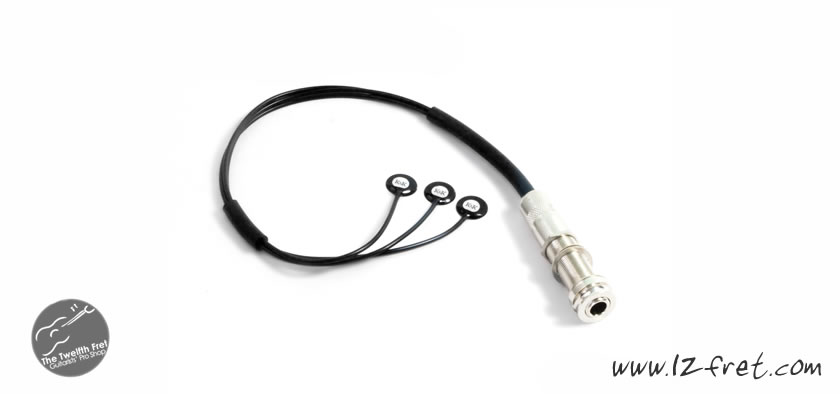
K&K Pure Mini Acoustic Guitar Pickup
K&K Pure Pickup
K&K Pure Mini Acoustic Guitar Pickup
Hands-down, our favourite acoustic guitar pickup here at The Twelfth Fret. The K&K Pure Mini Acoustic Guitar Pickup consists of 3 transducer sensors that are glued to the underside of your guitar’s top; on the bridge plate, to be precise. While most transducer pickups on the market work by feeling the strings vibrating down through the saddle, the K&K Pure pickup is feeling your guitar’s top moving. This makes all the difference to the tone produced by the pickup. The K&K Pure sounds clear and natural, discreet, balanced, with fantastic dynamics, and none of the “click” or “quack” typical of under saddle transducers. Most importantly, it sounds very much like your guitar. While other transducers amplify the strings, the K&K Pure does a nice job of amplifying the distinct tonal properties of your guitar. It is a passive system, meaning there is no battery or preamp involved. Most passive systems on the market suffer from thin, weak signal levels. But the K&K Pure sounds thick and full with a surprising amount of headroom. Players who are performing in extremely loud on-stage situations, such as a full rock band with live drums and bass and electric guitars, may find the K&K doesn’t give them quite as much juice as they need. An external preamp can help with that, or you may choose a pickup that works a little better in extremely high volume scenarios. But for most situations, the K&K Pure is without a doubt the best option to amplify your acoustic guitar.
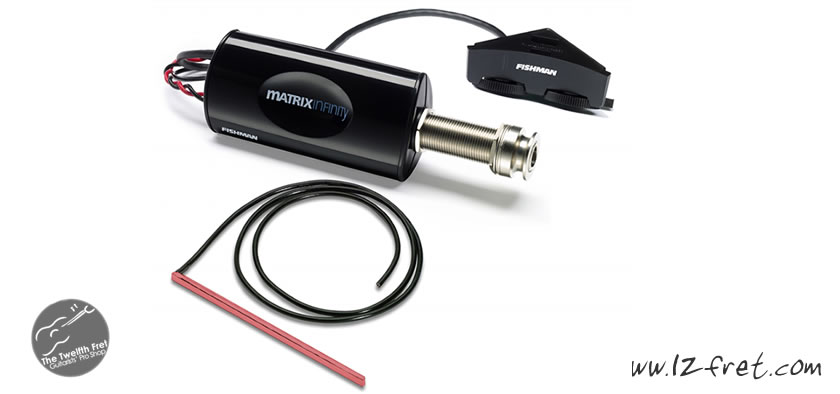
- Fishman Matrix Infinity
Fishman Matrix Infinity
Fishman’s undersaddle piezo transducer pickups have been the industry standard for decades. While far from the best sounding pickup on the market, there is something to be said for the reliability and consistency of the Fishman Matrix Infinity pickup. A piezo transducer pickup installed under the bridge saddle of your guitar does almost nothing to capture the natural tonal properties of your guitar itself. Basically, they just amplify the sound of your strings vibrating through the bridge saddle. This is why they sound so consistent. It doesn’t matter if you’re playing a Martin D-18 or a Taylor 314ce or a 2×4 with some strings stretched across it, the signal coming from your pickup will be virtually identical. Every sound engineer in the world has experience mixing and amplifying these pickups, so when you walk on stage on plug in your guitar, they will know what to do with it. The problem is that the sound coming out of your Fishman Matrix Infinity pickup doesn’t actually sound like an acoustic guitar at all. The Matrix Infinity includes an internal battery powered preamp, so there is plenty of headroom. It has great balance, a nice rich low end, crystal-clear trebles… but the sound it produces is that of a plastic pick clicking against quaky metal strings. Totally functional, but from a tonal point of view it pales in comparison to the K&K Pure pickup.
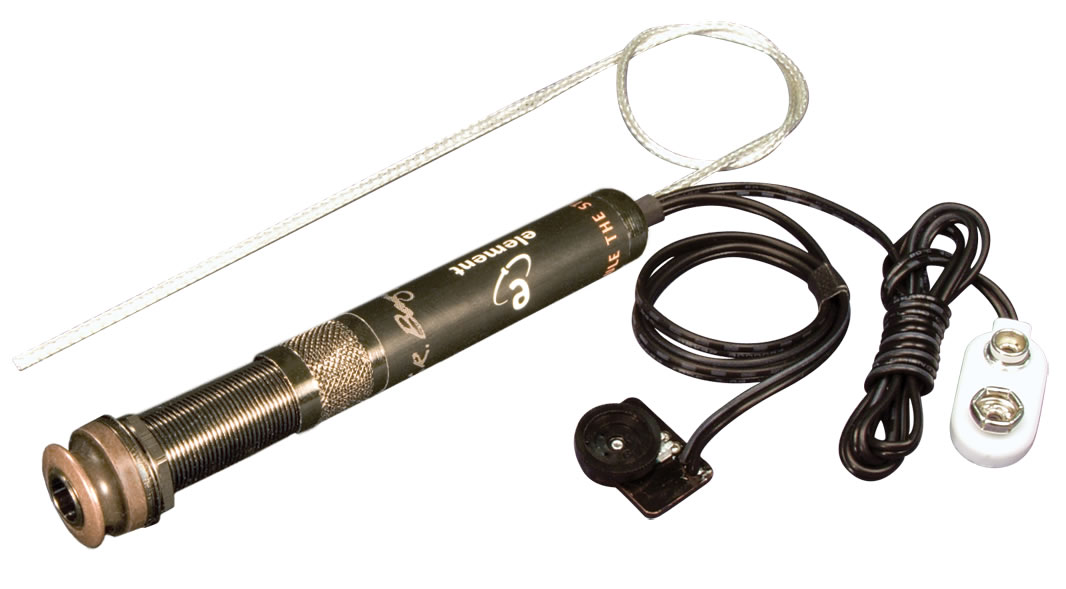
- LR Baggs Element Active
LR Baggs Element Active
The LR Baggs Element Active pickup is another undersaddle transducer with a powered preamp, similar to the Fishman Matrix Infinity. As such, it shares many of the tonal characteristics of Fishman’s undersaddle piezo; great balance, strong signal level, and very consistent. Also like the Matrix Infinity, the sound produced by the Element Active does not really sound at all like an acoustic guitar. However, there are some differences worth mentioning. When designing the Element, LR Baggs chose to use a soft, braided material for the transducer element itself. This does seem to help create a slightly warmer, less “quaky” tone than the Fishman Matrix. Given a choice between the two, most would find that the Element Active produces a signal that is a little nicer sounding than the Fishman Matrix. There is a drawback, however. That soft, squishy, braided material gets installed under your guitar’s saddle. That means you are essentially putting a tiny pillow between your saddle and the top of your guitar: the primary point where all vibration flows from your strings, down into your guitar. And you can hear the difference. Several of our customers have pointed out to me over the years that acoustically speaking, their guitar sounded a tiny bit better before they installed their LR Baggs Element than it did afterwards. The Element seems to act as a bit of a buffer between your strings and your guitar, soaking up a tiny bit of the resonance and vibration that would otherwise be going through your instrument. It is subtle, but noticeable nonetheless. Because of this, I rarely find myself in a situation where I recommend the LR Baggs Element as the best option for a player. It sounds better than some other piezo transducers, but still nowhere near as good as the K&K Pure, or certain SoundHole pickups. Plus it has a negative impact on your guitar’s acoustic tone, which is never a desirable outcome.
Soundhole Pickups
Acoustic guitar Soundhole pickups have earned a bad rap over the years, and often justifiably so. But there have been a few fantastic Soundhole pickups developed in recent years that deserve consideration when looking to amplify your guitar.
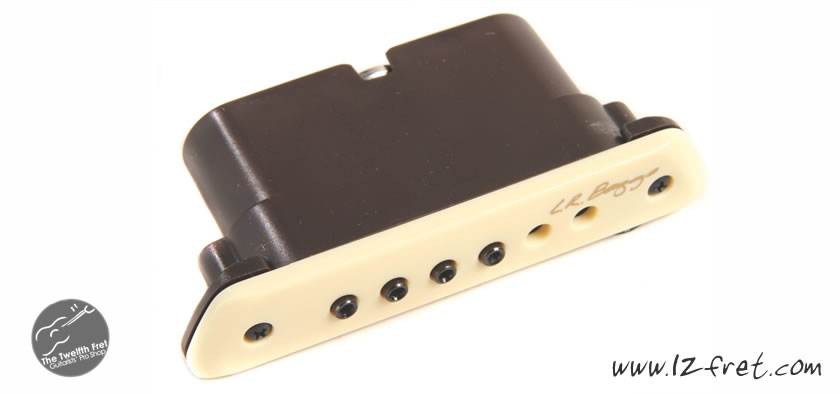
- LR Baggs M1 Active
LR Baggs M1 Active
The M1 Active by LR Baggs is a battery-powered humbucking magnetic pickup that mounts across the soundhole of your guitar. A magnetic pickup can seem like a counterintuitive solution for capturing the tone of an acoustic guitar, but they can work quite well. Of all the soundhole pickups on the market, the LR Baggs M1 Active is our favorite. Where it really excels is in providing a thick, full, decent sounding signal with good feedback projection and lots of headroom. It is my go-to recommendation for anyone playing acoustic guitar in a loud rock band with extremely high on-stage volume to compete with. From a tonal point of view, the M1 Active doesn’t sound as clear or natural as the K&K Pure pickup, but it is nicer sounding than any undersaddle piezo on the market.
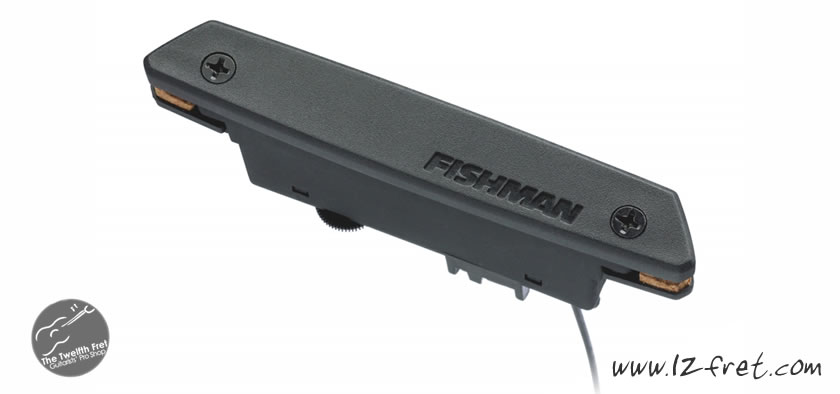
- Fishman Rare Earth Active Humbucker
Fishman Rare Earth Active Humbucker
Fishman’s active humbucking soundhole pickup is a worthy competitor to the LR Baggs M1 Active. Very similar in every way. When doing side-by-side comparisons, we find customers end up preferring the tone of the M1 Active more often than not, but it isn’t a wide margin. We find the Fishman Rare Earth humbucker sounds slightly flatter than the M1 Active. Not quite as thick and full in the midrange. But a great pickup nonetheless, if you need a strong signal level with better-than-usual feedback rejection.
Blender / Multi-Source Systems
One final note about the multi-source pickup systems on the market. There are several big name brands that make elaborate pickup systems consisting of some form of transducer pickup, paired with an internally-mounted goose-neck microphone, all blended together through an internal preamp. In most cases, we find these systems to be more trouble than they are worth. Mounting a microphone inside your guitar rarely produces a desirable tone. Even if the microphone is a decent one, and even if you are able to avoid feedback, guitars don’t sound the same on the inside as they do on the outside. In reality, most people who perform with these systems find they need to turn the internal microphone almost all the way down, just to avoid feedback. So the vast majority of the time, these systems end up being used with the simple undersaddle piezo pickup generating 95% of the tone. Given the cost, and the fact that you get far better tone from a simple K&K Pure pickup or even a soundhole pickup, these multi-source systems are rarely worth the cost or hassle.
That’s it for our acoustic guitar pickup roundup! We hope you find this helpful when choosing your next pickup. If you have any questions, feel free to call us or email us any time.
~Nevin Douglas, The Twelfth Fret Guitar Shop
